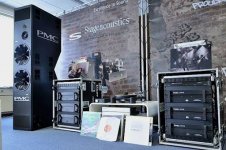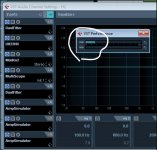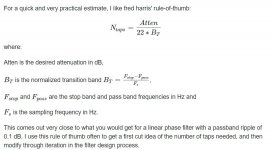No amount of digital trickery is going to fix that. Might sound a little better... but it will always sound like a "patches" design and not a good one
Maybe. Today's digital filter design has been improved a lot last 10-20 years, but I think it is still less than ideal. We just may not have enough DSP power for good sounding real time processing. Finger crossed.
Sorry but this is not true ( about hiss, other point is real in big venues): do you think that a FOH will tolerate hiss in a large venue and you won't hear it? Really? With some Vdosc or other line arrays or nice big PA? Something with 115db/1w/1m efficiency?
This isn't serious comment to anyone which goes to amplified events whatever the genre of music played. Even more when you have to setup a system like this.
Fair enough. But are you saying that you can hear the same hiss from the same system - at - lets say - 100m distance surrounded by 2000 people - compared to sitting in a comfy quiet home - alone - 3 meters from the speakers?
Simple logic says - higher volume - somewhat higher SNR - right?
Further more. Higher frequencies(hiss) tend to die off quickly with distance.
I never said that what I use is absolute king. I just say, that most of the products from - for example Minidsp and behringer, that most people go for, when trying active the first time - cause it's cheap. They tend to have not so good SNR.
The Gruondsound I own is sadly no longer produced. But was created because there was no product on the marked at that time to produce a top notch level of performance in a home DIY stereo system.
Good products are comming though and I heard more and more DIY with active solutions from minidsp, hypex and the like - that could sound great.
And there might be some great pro products, that can be modded to be used with some care, in a home stereo system.
The latest posts testify to reason.
Active vs passive, as well as analog vs digital, isn't strictly black and white.
Although active (dsp) has been commonplace in the PA world for years, it's emerging in traditional hi-fi.
In audiophile circles the word "dsp" is still received with condescension.
That said, about 8 years ago, a semi-diy loudspeaker system caused a stir at the national HiFi show. The majority of visitors, exhibitors and members of the organisation agreed it was among the very the best systems of the show, if not the best.
Obviously, it wasn't this € 100.000, Bryston powered, active PMC XB2 studio monitor system (that was loud, but also ridiculously bad).
Active vs passive, as well as analog vs digital, isn't strictly black and white.
Although active (dsp) has been commonplace in the PA world for years, it's emerging in traditional hi-fi.
In audiophile circles the word "dsp" is still received with condescension.
That said, about 8 years ago, a semi-diy loudspeaker system caused a stir at the national HiFi show. The majority of visitors, exhibitors and members of the organisation agreed it was among the very the best systems of the show, if not the best.
Obviously, it wasn't this € 100.000, Bryston powered, active PMC XB2 studio monitor system (that was loud, but also ridiculously bad).
Attachments
Last edited:
What I refer too - if not clear. Is that basic issues like polar response, internal reflections, bad driver mixup and so on. Is never going to be fixed by a DSP.Maybe. Today's digital filter design has been improved a lot last 10-20 years, but I think it is still less than ideal. We just may not have enough DSP power for good sounding real time processing. Finger crossed.
Basic good design is still key to good sound.
An active system, merely add better control over the drivers in many ways, by removing the passive component between the drivers and the amplifiers.
But mostly the popularity is gained, by drop in prices for amplifiers(often class D), DSP's, measurement equipment, the ease of use of modern software + computer power and better 24/7 help from the internet.
One question. Have you ever compared 6000 vs 100,000?
They sound completely different. You should hear the difference clearly at low frequency.
Yes, up to 131,072 taps per channel.
Anything above 4,000 taps, covers 100Hz up without further need imo.
It's all about magnitude and Q of corrections, and the order of xover.
Exceeding reasonableness with any of those, may give an audible difference, but should be avoided.
Ime, unless you go outdoors, you will have a hard time hearing any difference in low frequency using 4,000 taps vs far greater.
If you are outdoors with response down to 20Hz, I'd say the most you would ever want is maybe 20,000 if trying to fully linearize.
One period of frequency time is about all the FIR time needed for valid reasonable corrections imo.
We really can't even talk in terms of taps alone, it always has to be in terms of taps @ what sample rate.
Lowering the sample rate for low frequencies is an effective way to gain FIR time. Check out what Four-Audio does.)
Oh, where do you get dsp processing is an issue?
PC's, even a rasPi, can handle all the taps we can eat.
Minidsp (4x10HD) is not particularly quite, it can produce reasonable results with digital sources, but if you have a TT just forget it, the ADC side is rubbish and your analogue source will take a BIG step backwards in sound quality.
The measurements on the 4x10HD would suggest it's more than good enough for a TT. Certainly in the last 2 years of using one as my preamp/ crossover I haven't noticed any fidelity loss on my vinyl sources. But it does seem a marmite product. I have got an external ADC to hook up at some point. I'll report if veils get lifted
This?
Tap – A FIR “tap” is simply a coefficient/delay pair. The number of FIR taps, (often designated as “N”) is an indication of 1) the amount of memory required to implement the filter, 2) the number of calculations required, and 3) the amount of “filtering” the filter can do; in effect, more taps means more stopband attenuation, less ripple, narrower filters, etc.
Tap – A FIR “tap” is simply a coefficient/delay pair. The number of FIR taps, (often designated as “N”) is an indication of 1) the amount of memory required to implement the filter, 2) the number of calculations required, and 3) the amount of “filtering” the filter can do; in effect, more taps means more stopband attenuation, less ripple, narrower filters, etc.
Last edited:
Totally agree.
<snip>
DSP devices get better every year, but quality comes at a price.
This is the only MiniDSP product I'd consider buying:
I'll vouch for the SHD, I was an early adapter - and former analog diehard. Nothing is ideal, but this was a big step up from the BSS varicurves it replaced. No regrets with my choice.
I run 65.536 taps. On 6 channels. Why? Because I can with a PC as source.
Using a proper DAC for mains, a multi-channel sound card for the other channels feeding ambient speakers and subwoofers. So that should make me multi-way (lol).
Even though DSP isn't a fix for a (bad) room, it can do wonderful things . In combination with passive room treatment it is a very powerful tool.
. In combination with passive room treatment it is a very powerful tool.
Using a proper DAC for mains, a multi-channel sound card for the other channels feeding ambient speakers and subwoofers. So that should make me multi-way (lol).
Even though DSP isn't a fix for a (bad) room, it can do wonderful things
This is the only part I don't really agree with. Indoors if you are manipulating phase to deal with room speaker interaction issues that is very audible and will need 16 to 24,000 taps to be effective. It is not a simple thing to do and is pretty easy to mess things up entirely as your other points suggest, but it can be done and when you get it right it improves the sound.Ime, unless you go outdoors, you will have a hard time hearing any difference in low frequency using 4,000 taps vs far greater.
From my own experience low frequencies are where the effects of phase manipulation are the most audible.
As a mobile DJ I know how different rooms can sound.
I have played very echoey dance halls and also some very damped rooms with carpets and drapes everywhere.
The louder you play the more echo.
The more drapes carpets etc the more power you need as the sound gets absorbed.
In my house with curtains and carpets there is very little to no echo that I can hear.
I have played very echoey dance halls and also some very damped rooms with carpets and drapes everywhere.
The louder you play the more echo.
The more drapes carpets etc the more power you need as the sound gets absorbed.
In my house with curtains and carpets there is very little to no echo that I can hear.
Mark, do you think there is some tipping point in terms of the complexity of a speaker system, beyond which FIR clearly offers advantages?
Or is FIR always better than regular IIR in your view?
Great question Ro808,
here's my 2 cent answer....
I currently believe the tipping point is 2-way for mortals, maybe 3-way for geniuses.
At 2-way, i think the only real advantage with FIR is finer and more numerous PEQ's for tuning.
But this assumes the two-way is using a first (preferably) or 2nd order xover. Above a 2nd order xover I'd use FIR, if only to upgrade to a linear phase xover.
At 3-way, if someone can stitch it all together using only first order xovers, and the design uses particularly smooth drivers, i think it might be a wash with FIR.
Super huge IF's though,..... odds strongly favor FIR imo, as xover issues compound greatly beyond a 2-way.
At 4-way or above, forget it, no chance in hell FIR won't win dramatically.
Xover's issues compound beyond handling with IIR, ime/imo.
This is the only part I don't really agree with. Indoors if you are manipulating phase to deal with room speaker interaction issues that is very audible and will need 16 to 24,000 taps to be effective. It is not a simple thing to do and is pretty easy to mess things up entirely as your other points suggest, but it can be done and when you get it right it improves the sound.
From my own experience low frequencies are where the effects of phase manipulation are the most audible.
I defer to your experience here.
Indoors, I do no testing with regard to FIR audibility down low.
I can maybe see how it would take more taps to try to manipulate phase indoors.
Still can't see why so many taps would be needed, though.
Have you found doing so evens out low end response over a wide area, or is it back to a spot?
Here's an old rule of thumb re taps required, in case it's of interest...
Attachments
Fair enough. But are you saying that you can hear the same hiss from the same system - at - lets say - 100m distance surrounded by 2000 people - compared to sitting in a comfy quiet home - alone - 3 meters from the speakers?
Simple logic says - higher volume - somewhat higher SNR - right?
Further more. Higher frequencies(hiss) tend to die off quickly with distance.
When i was comissioned to live events ( P.A., made a few but i was more into studio works) i was paid for a given level at a given distance (more over an area but still). Yes the ambiant noise is higher than at home but overall spl too. Overall SNR is not really different and the spl (and thus high frequency level) is supposed to be the one specified by client at the farthest location to be covered: iow the distance loss is more or less covered by number ( and type) of box used for hf.
I've never been in a case where the distance was this far away that the loss was an issue, however there is some techniques that can be used to compensate for that ( ever seen some big festivals where there is a second set of sound system past the mixing booth? It is delayed and level matched to compensate loss and 'support' the main FOH signal. When correctly set up you don't hear them as a source and crowd often ask why they are off...).
I've had issue with temperature change and hf bouncing to the sky at sunset or sunrise, sound changing with increased crowd but all this are subject altogether...
Anyway, SNR if your gear is 'good' should not be an issue and not at processor stage. If an hiss happen then you have another issue after in the chain: impedance mismatch, bad cables,... If this come from the processor it is not adapted to the task and must be changed to a better unit.
I just say, that most of the products from - for example Minidsp and behringer, that most people go for, when trying active the first time - cause it's cheap. They tend to have not so good SNR.
I've not heard the new offer of minidsp so can't talk about them but the one i've heard some 4 to 5 years ago weren't good to me and Behringer lasted maybe 6 month at home before other solution took place.
The Gruondsound I own is sadly no longer produced. But was created because there was no product on the marked at that time to produce a top notch level of performance in a home DIY stereo system.
Well, it is not like if good quality pro or semi pro soundcard existed at that time.
To be honest if you want to try FIR ( for filtering not DRC) a dedicated processor is not the way to go imho: a pc some older software and plug ins and a multichanel soundcard is way cheaper. I run a secondary system with a dual 3ghz pc with 2giga ram under windows xp with an Aardvark soundcard- previous brand of Antelope engineers-. Overall cost including soundcard is below 200euros and sound is great ( Aardvark sounded very good and 'warm', a bit like older ( first gen?) Apogee converters which mimiced tape saturation).
I agree this is not plug and play, it won't run at 1megahertz sample rate ( please could someone explain me what is the interest of very high FS, when 90% of studio run at 96khz max and more often 44,1 or 48k?), you'll need to setup a daw or vst host and use virtual cables and drivers... yes it is a bit technical but if you enter FIR you'll probably have to do that kind of geek occupation anyway.
Last edited:
What I refer too - if not clear. Is that basic issues like polar response, internal reflections, bad driver mixup and so on. Is never going to be fixed by a DSP.
Basic good design is still key to good sound.
I agree 100%.
I must say i don't get the analog versus digital controversy.
These are two different approach with pro and cons. Both if correctly implemented ( from what i've seen which come with experience for passive xover and knowing when to stop using dsp) can sound very good.
Mix and match both can have advantage too.
Manninen,
Yes i heard differences between IIR and FIR with our units but i was refering to difference between processors (or plug ins) with for example a LR24.
I've heard difference too with FIR on an other processor ( Xilica 5/6years old unit): the way the filters are programed/coded/processed change their sound and overall rendering.
When Plasnu said that Equilibrium or Weiss eq sound good (i will say Flux's plug ins are in the same category too) i understand what he is talking about and agree. All software algorythm are not born equal ( let aside the hardware parts). This is true in analog and in digital.
The need in processing power is true with FIR xover. That said processing power and memory grown fast in the last ten years, maybe developpers optimised the code too and now you can have all this in a tiny compact box. But it can't be realtime. This is the nature of the treatment.
Is it even 'needed'? There is a lot of evidence of very good sounding passive systems so IIR can bring very good results.
In some case it brings benefits to have steep slope and no phase shift. Is the difference day and night? No but there is difference in rendering so if it suit your preference...
Is it convenient to use? Can be nightmare to non engineers (or non geek people).
All in all it is a balancing act between needs and wish. As long as your happy with outcome ( if you are not and keep on changing gear maybe it is time to treat the room...).
Last edited:
- Home
- Loudspeakers
- Multi-Way
- Are you ACTIVE ?? (multi-way)


